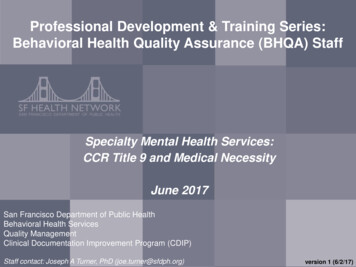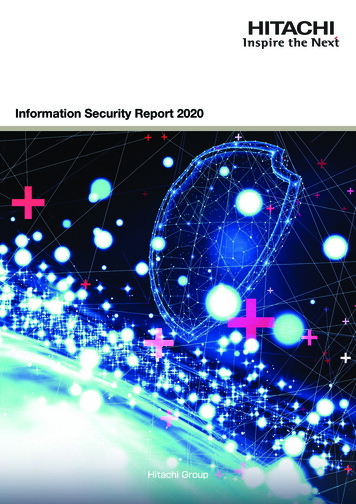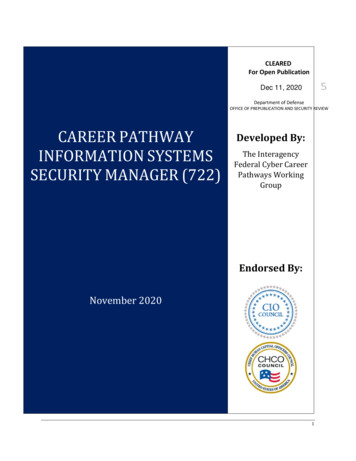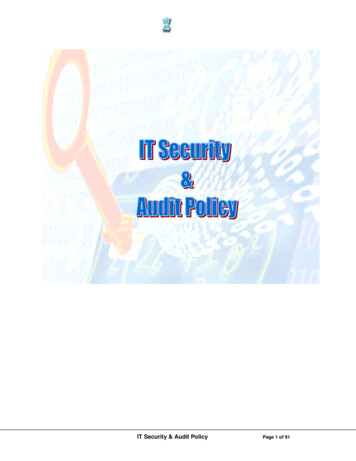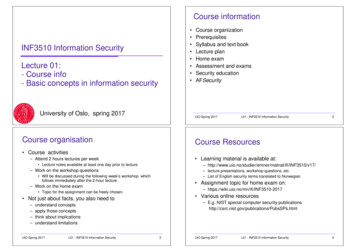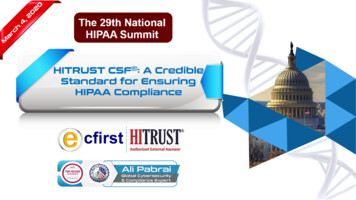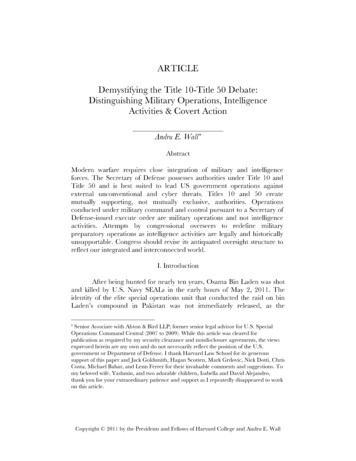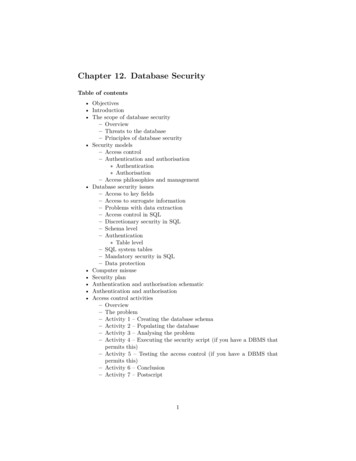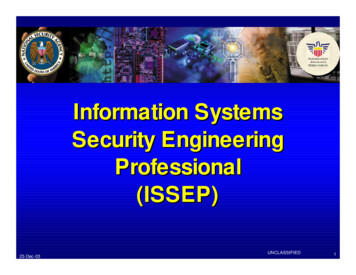
Transcription
Course title: INFORMATION SYSTEMS SECURITYLecturersAsst.Prof. Tonimir Kišasondi, Ph.D.Language ofinstruction:Schedule:Croatian and English60 teaching hours-4 hours per week (2 hours lectures 2 hours laboratory exercises)Study levelMasterStudy programmeInformation / Business SystemsSemesterWinterECTS5GoalIntroducing the students to problematics of information system security,especially in conditions of dependency of business systems upon businesscontent communication with support of information technology. Europeanlegal regulative and means of fulfillment of that regulative as a pre-conditionfor certification. Introduction to methods of design and development ofsecurity. Role of individual measures for reduction of risk levels in individualsegments of information system. Development of skills of construction ofparticular security measures.The goal of exercises is to introduce the students to technical means forrealization of particular forms of protection and security of informationsystems. After passing the colloquium of exercises, the students should be ableto build and manage protection of segment of information system supportedby computer through aspects of protection which may be implemented onthat level.Content1.Meaning of information system protection (4 hours)Notion of security and protection of information system efficiency; reasons forprotection of information system; dependency of organizational developmentof business system upon efficient protection of information system. Historicaldevelopment of system of protection and security with indicators of possibledirections of development.(2 hours)Meaning of information content; economical, cultural or political motives ofthreat; types and forms of threats throughout history; threats to hardware andstructural elements of information system; threats to software foundations;threats to communication system; threats to operators. Notion of computer
crime, origins, development and form of computer crime, carriers ofillegitimate activities based upon information technology. (2 hours)2.Approach to information system projecting (8 hours)Planning and projecting security and protection in course of informationsystem development. Review of standards used in projecting security ofinformation resources; means of realization of information system securityaccording to place of threats and according to place and method of protection.(2 hours)Steps in development of security system of business information system;defining the policy of information system security; choice of strategies fordevelopment of security systems of information system; choice of responsibleparties for building security systems; choice of approach to mode of realizationof security system. Evaluation of significance of business system data content;external factors of business content significance, internal factors of businessdata content significance; evaluation of forms and intensities oftodata content regarding the evaluated content.threats(4 hours)Risk analysis; evaluation of risk of a particular content; quantitative measuresof evaluation; fields of application of this method and qualitative measures ofevaluation. Choice of protection measure. Security measures. Riskmanagement, analysis of risk types, priority setting, plan of information systemsecurity. Plan of recovery from disaster. Valorization of efficiency of securitymethods. (2 hours)3.Organizational, program, technical and physical securitymeaures (12 hours)Modes of realization of organizational, program, technical and physicalsecurity measures. Means of technical security. Boundaries of organizational,program, technical and physical security measures. (2 hours)Protection measures of information systems; material carrier as a protectionmeasure; program protection measures; protection on the level of operationsystem; protection on the level of applicative program support; safety copywith change of material carrier as protection measure; protection bycryptographic protection measures; symmetric crypto systems; asymmetriccrypto systems; function of digital signature; modes of realization of digital
signature; infrastructure of digital signature; fields of application of digitalsignature. (3 hours)Anti-virus protection; history of virus origins; notion of virus and types ofmalicious software; routes of virus infection; consequences of virus attack;types of virus according to method of hiding; types of virus according tomethod of operation; methods of prevention in anti-virus protection; methodsfor virus detection; possibilities of program solutions for virus identification;“cure” and recovery of infected system. (3 hours)Technical measures of protection; measures of protection on the level ofcomputer system; measures for increasing redundancy of equipment,depending upon risk of content disappearance and continuity of systemfunctionality; protection measures made by setting alternate power systems;impeding access into protected area; supervision of area during trespassing;safety locks; chip cards; biometric inspection; fingerprint; geometry of hand;geometry of head; constitution of eye iris; voice checking; combined measuresof inspection; conditions of application of a particular measure; physicalprotection measures; structural protection measures; placement of sensitiveinformatic equipment in space; placement of equipment within the building;measures of fire protection; preventive measures, identification measures andmeasures of fire extinguishing. (2 hours)Organizational protection measures; choice of norm; application of norm;elaboration of required organizational and implemental acts as organizationalmeasure; system of certification of measures applied according to particularnorm. Protection measures in legal domain, relation of the state towardsecurity system through passing of particular acts, normative acts related tosecurity within business system. Validity check of applied protection measures.(2 hours)4.Data security during processing and storage: (4 hours)Realization of security on the level of operational system; licences andcopyrights; comparison of Windows protection systems and concepts ofprotection on Unix platform; protection system with use of password; policiesof password assignment and change. Assignment of user interface, deletionand temporal revoking of user interface, rules of exclusion. Conditions andmodes of security firewall setting . (2 hours)
Security on the application level; creation of user interface; assignment ofsystem resources according to problem domain of a workplace. Data storageon carriers with analogue inscription. Means of storage with digital inscription;system of security storage; normal storage; incremental storage; differentialstorage; daily storage; storage strategies. Multimedia systems of storage. (2hours)5.Other aspects of information system security (2 hours)Security standards. Legal protection of softwares; copyright; ownership ofsoftware product; licence rights. International aspect of information systemprotection. Efficiency analysis of the applied protection methods ofinformation center content and users; evaluation of functionality ofinformation protection. Ergonomical aspect of information system security. (2hours)ExercisesExercises:1.Safety settings in Windows XP operational system (2 hours)User accounts – types, creating, rights. Modes of system access (used securityprotocols). User groups. User account management. Local Security Settings –policy of user accounts, local politics, limitation of software access, IP securitypolicy.2.Security settings in NTFS file system (2 hours)Features and structure of NTFS file system. ACL. NTFS access rights toresources. Supervision and analysis of access control. Encrypted file system.3.Security settings in Linux 1 operating system (2 hours)Linux users and groups – storing of user information; change of users andpasswords. Means of system registration (used security protocols). Supervisionof users – quote, setting limitations through PAM, bash limitation. Use ofWebmin tool for configuration of users, groups and related properties.4.Security settings in Linux 2 operating system (2 hours)Critical systemic configuration files. Following system notes – general securityof notes, system notes. Cryptographic file system – Linux CryptoAPI.5.Cryptography – PGP/GPG (2 hours)Asymmetrical cryptography. Implementation of asymmetric cryptographythrough PGP/GPG tools. Installation and configuration of PGP and GPG
(GnuPG) tools (Windows/Linux). Generating the pair private/public key.Exchange of public keys through key-servers and key-server search.6.Cryptography – PGP/GPG (2 hours)Use of PGP/GPG tools – encryption of files and e-mails, digital signature; fileand e-mail decryption; digital signature validity check.7.Anti-virus protection and firewall (2 hours)Norton Antivirus – installation, setting customization, media scanning,restoration of base with virus definitions, reports, carantine. Purpose offirewall, device for traffic filtering. Personal firewall – Integrated WindowsFirewall (ICF), Kerio Personal Firewall, Sygate Personal Firewall – installation,configuration, filtering rule definition8.Security data storage (1 hour)Types of security storage – copying (with or without compression), commonbackup, differential and incremental backup. Security storage of systemcomputer settings. Application through Windows Backup Utility.In the course of exercises, the students use standard program tools, which arecommercially used for support to electronic business operations, and applythem to practical examples. The students learn to create XML documents andtheir definitions, to transform XML documents and to transfer them intovarious specifications. Furthermore, the students use standard commercialtools for support to managing the chain of supply, learn about its parameters,setup principles and usage mode.PreconditionsRealizationexamination-and Classes: Lectures, seminars and exercisesExam: Compulsory testing of practical work on computer as a pre-condition fortheoretical part of exam, which is realized in written and oral examination.Written part of examination consists of seminar evaluation and several writtentests during lectures, or written tests after lectures. Oral part of examinationis evaluation of authenticity of previous results and possibility for gradeimprovement achieved through written exams. The exams are partiallyconducted through LMS.Related courses1.IT-Security, TUG (Techniche Universitat Graz)
Literature2.Telematik IV - IT Security, Albert-Ludwigs Univ., Freiburg3.Computer and Network Security, University of FloridaBasic:1.BS ISO/IEC 17799:2000 - BS 7799-1:2000 norma - InformationTechnology - Code of Practice for Information SecurityManagement, BSI, UK, 2001.2.Peltier R.T., Information Security Risk Analysis, Auerbach, CRCpress, 2000.3.Tudor J.K., Information Security Architecture, CRC Press LLC, USA,2001.Exercises:1.Bott E., Siechert C., Microsoft Windows XP Inside Out, MicrosoftPress, 20012.Linux dokumentacija, URL: n J., Biometrics - Advanced Identity Verification, SpringerVerlag, UK, 2000.2.Humphreys E.J, Moses R.H., Plate A.E., Guide to Risk Estimationand Risk Management, BSI, UK, 1998.3.Scheiner B., Applied Cryptography, John Wiley & Sons Inc., USA,1996Thorenson J.D., Blankenship J.H., Information Secrets,Valuable Information Ltd, USA, 1996.Exercises:1.Various textbooks and on-line documentation for program toolsused in exercises course.
Personal firewall – Integrated Windows Firewall (ICF), Kerio Personal Firewall, Sygate Personal Firewall – installation, configuration, filtering rule definition 8. Security data storage (1 hour) Types of security storage – copying (with or without compression), common backup, differ
